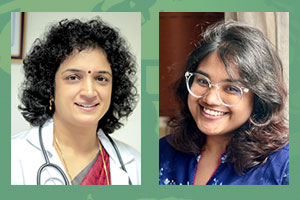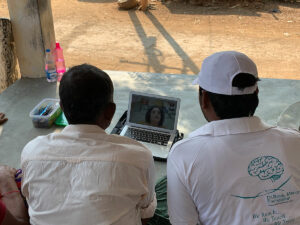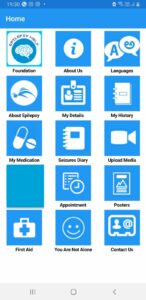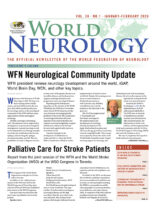Identifying problem statements, technology can help provide simple solutions that go a long way in bridging lapses in treatment.

Dr. Bindu Menon and Dr. Medha Menon
By Dr. Bindu Menon and Dr. Medha Menon
Epilepsy, when put simply, is a brain disorder that causes recurrent seizures. This disease can manifest as the typical jerky movements of limbs as well as only sensory complaints recorded as electrical disturbances on electroencephalography (EEG). This wide variation of disease manifestation makes it a condition one must be wary of and have a high index of suspicion. The number of cases of epilepsy touches 50 million globally, 80% of whom reside in middle- to low-income countries like India1.
It is important to realize why one must be wary of a disease that’s prevalent in such high numbers. Surely, its ubiquity implies the presence of a well-structured management plan? However, the enormity of the problem can become the hamartia of the disease.
 One must first realize that more than three-quarters of the disease burden resides in regions that are struggling to bridge the treatment gap. In a world where everything is run by money, the catastrophic expenditure on health burdens every family in the lesser privileged sections of economy. This expenditure encompasses costs of medication, hospitalization, and continuation of care. The onus to balance livelihood and health falls on the patient, and when this burden becomes too much, they tend to stop being compliant to treatment — an ignition to the vicious cycle of expense and hospitalization.
One must first realize that more than three-quarters of the disease burden resides in regions that are struggling to bridge the treatment gap. In a world where everything is run by money, the catastrophic expenditure on health burdens every family in the lesser privileged sections of economy. This expenditure encompasses costs of medication, hospitalization, and continuation of care. The onus to balance livelihood and health falls on the patient, and when this burden becomes too much, they tend to stop being compliant to treatment — an ignition to the vicious cycle of expense and hospitalization.
Another stark problem one sees in the lower income countries is the stigma attached to the disease. The typical flailing of limbs often described as demonic possession in archaic times still brings out a level of unnecessary discomfort in onlookers of a seizure episode. These thoughts are easily curbed through a proper understanding of the disease. In a way, the stigma that hurdles a patient’s progress when vanquished empowers the community to provide moral support to the patient and their family.
The root of these problems is often lack of knowledge of the disease and so it is only natural that the solution is proper education and awareness. In this digitally advanced world, we must keep up and take advantage of the speed and extent of the reach of technology. Where once it was physically difficult to reach remote areas, in this day and age the internet and satellite connections help us reach the same areas remotely.
One such advancement is the Epilepsy Help App launched by our Foundation in India2 April 2016 — a free mobile app that can be downloaded on Android phones. It is available in English as well as vernacular languages and keeps record of a patient’s personal details, appointments, and reports.
When a patient presents to the emergency department with a seizure, it is of utmost importance that the doctor knows which medication and dosage the patient is on. The app shows the record of patient’s medications as well as has alarms for taking them, since a single missed medication can prove to be devastating to their life. Besides this, the patient can maintain a seizure diary within the app. The app has facilities for a bystander to take a video of a patient having a seizure attack, which proves to be of great value to a doctor to discern a diagnosis. On the whole, this app helps keeps track of a patient’s disease for their as well as the doctor’s benefit.
 Among the patient stories we have permission to share was of one college student on three anti-seizure medicines. He often received different injections in the emergency department and was prescribed different cocktails of medicines due to his lack of record keeping. But with this app, he is documenting his prescriptions and scans and has currently been seizure free for eight months. The most useful feature for him, “For me, the drug reminder alarm is a huge help, and it makes sure I have not missed medications like I used to before.”
Among the patient stories we have permission to share was of one college student on three anti-seizure medicines. He often received different injections in the emergency department and was prescribed different cocktails of medicines due to his lack of record keeping. But with this app, he is documenting his prescriptions and scans and has currently been seizure free for eight months. The most useful feature for him, “For me, the drug reminder alarm is a huge help, and it makes sure I have not missed medications like I used to before.”
Another story was about the usefulness of keeping a video diary. An office worker who stayed in the dorms away from his family suffered from jerky motions, which were misdiagnosed as a seizure attack. Hence, he was put on wrong medication. But record-keeping of videos at several instances — once in the dorms, another at his home, and one while he was outside with friends who all knew of the app in his phone, helped in reaching the right diagnosis of a nonepileptic attack disorder upon physician review.
Another application is a Tele Awareness3 initiative, which is a toll-free number that can be called to receive information about epilepsy. It is accessible to all, and this number when disseminated in large numbers when in medical camps, helps ensure that the general population is made aware of the disease, its risk factors, management, and the need for treatment compliance. Furthermore, it is in these medical camps that they are made aware that the societal stigma about the disease needs to be abolished.
Stroke is another disabling disease that affects everybody differently. The life of a patient and their family changes drastically after a stroke which makes rehabilitation a crucial part of the spectrum of stroke care. Rehabilitation is all about getting back to a normal life and living a life as independently as possible. A venture in this direction is the Stroke Help app. This app has various physiotherapy exercises which are specific to the stroke deficits. The exercises are for passive and active limb exercises, handgrip and dexterity, positioning of the body, turning and mobilization, visual training, and balance exercises. This app has been extremely helpful for stroke patients especially during COVID, when medical services were not as accessible, but we did not want to falter in patient care. It is still being used4.
A novel project in the country is the Neurology on Wheels program where treatment-inaccessible areas are approached in a bus equipped with medical facilities. It follows the motto, “We Reach, We Teach, We Treat” Upon reaching the remote areas, there is an awareness camp followed by a medical camp with distribution of free medicines. An extension of this is We Care, wherein patients with epilepsy are followed up remotely. This is done with the help of the village head who gathers the patients in one place and sets up a telecommunication link to the doctor who can then follow up with each patient. This ensures compliance and treatment satisfaction especially in a resource-poor setting by curbing expenditure from both ends.
Technology doesn’t need to be used in grandiose gestures to be of use to the people. Identifying problem statements and finding simple solutions goes a long way in bridging lapses in treatment. A resource-poor country does not imply that the whole nation is lacking. Technologically linking the better-off areas to help the lesser privileged sections doesn’t have to be a lofty feat. Once the key to unraveling the tangled ball of problems is in sight, it is only a matter of like-minded individuals putting smart and economic solutions to improve health care. •
Dr. Bindu Menon is professor and head of the department at Apollo Speciality Hospitals in Nellore, India, secretary general of the Indian Epilepsy Association, and president of Dr. Bindu Menon Foundation. Dr. Medha Menon is resident in internal medicine at the Kasturba Hospital Manipal, India, and treasurer of the Dr. Bindu Menon Foundation.
References:
